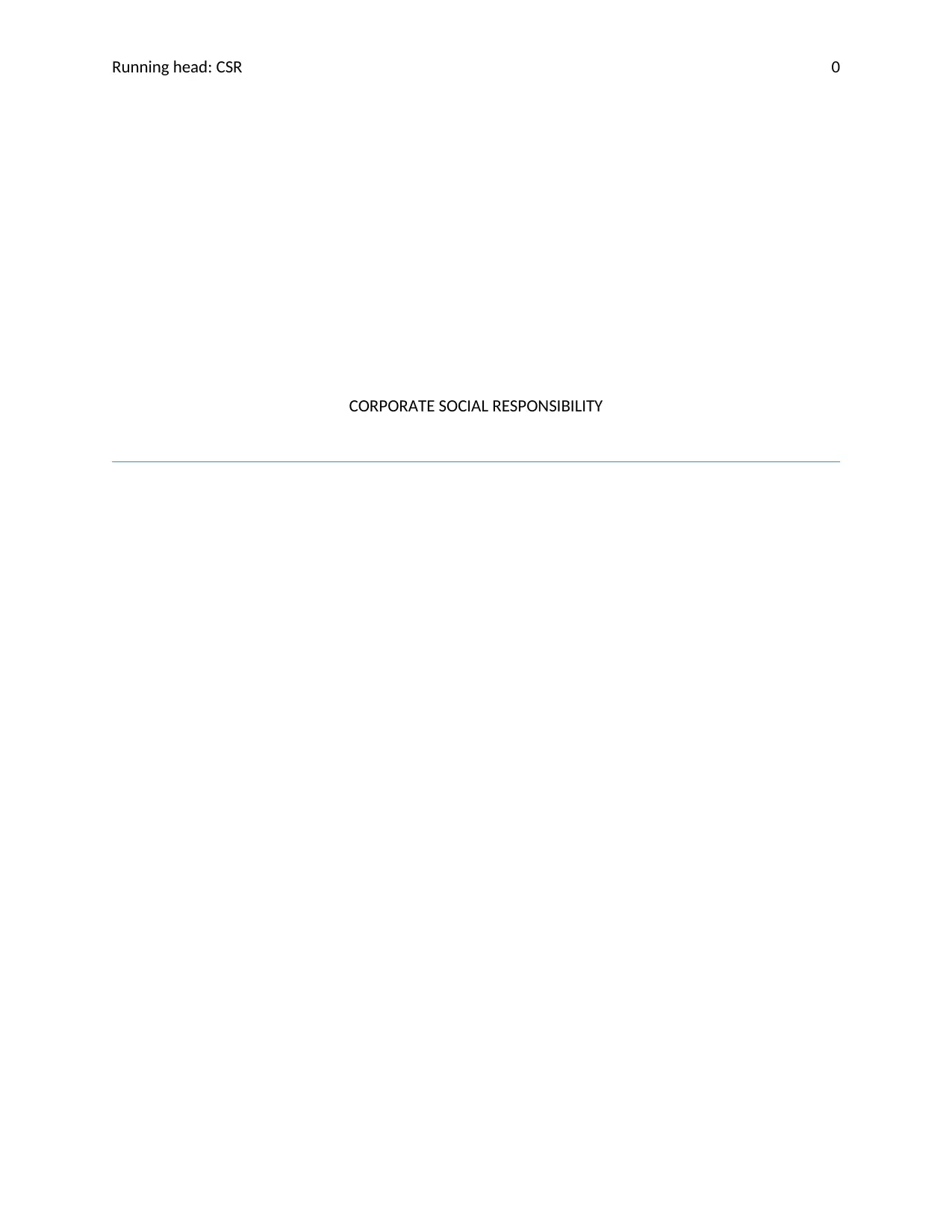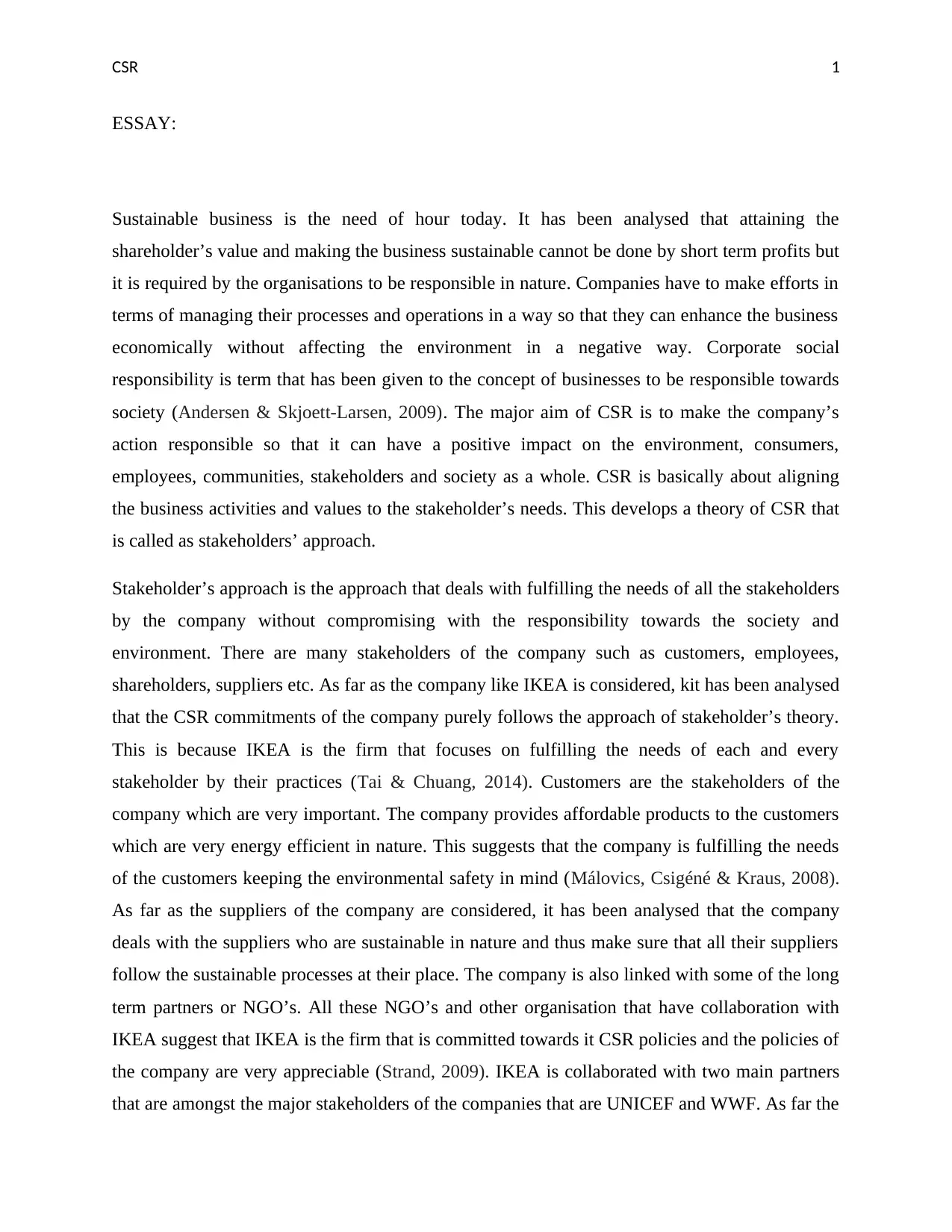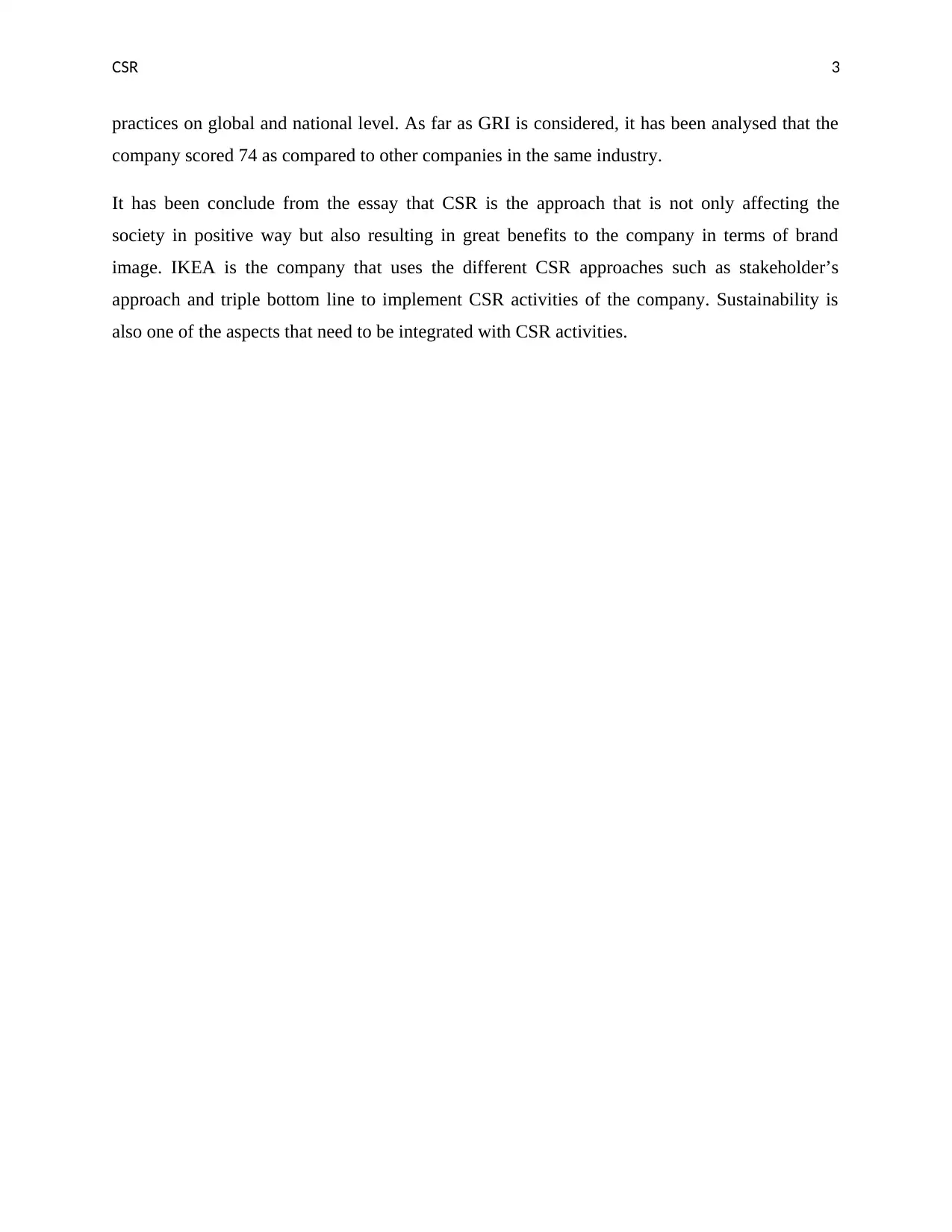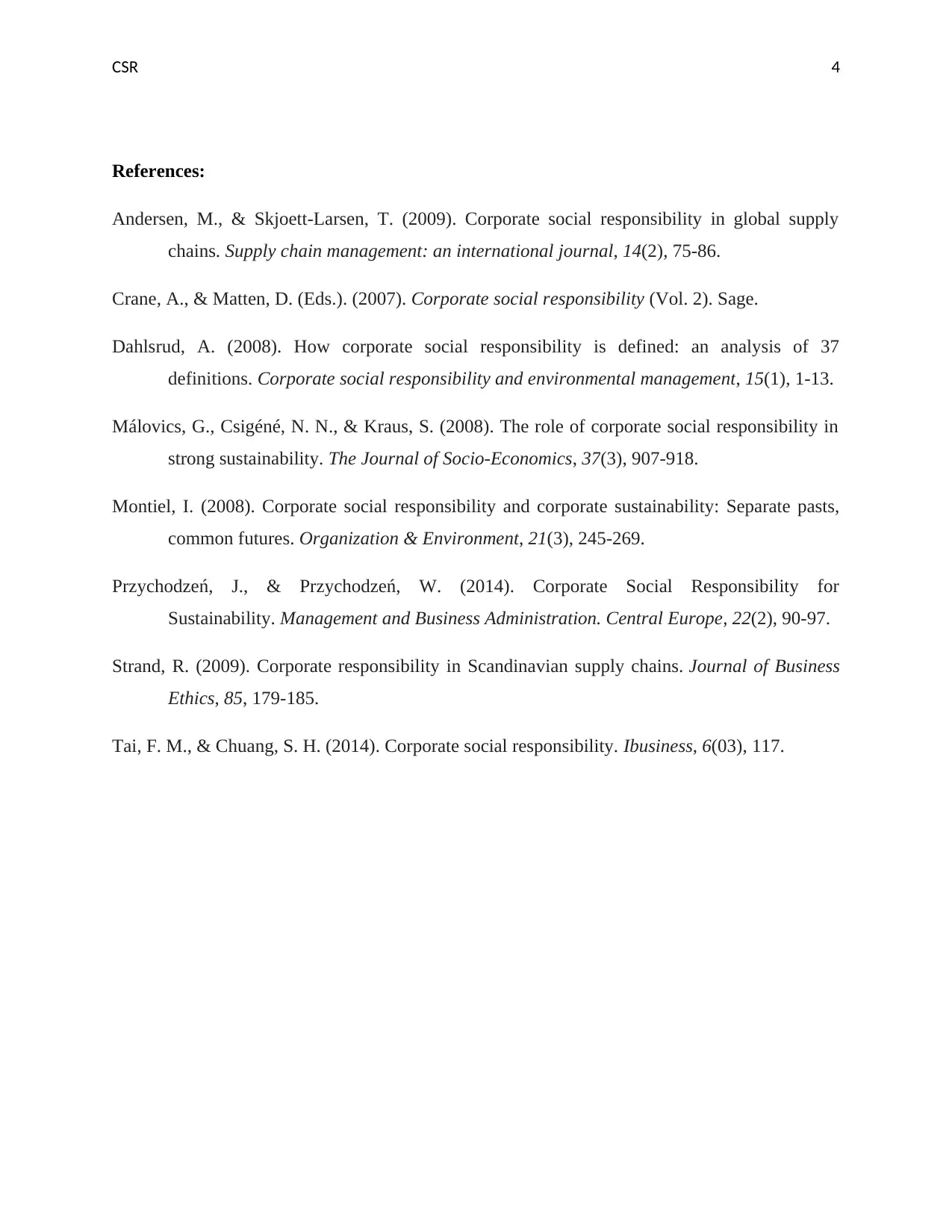Corporate Social Responsibility Essay: IKEA's Sustainable Practices
VerifiedAdded on 2020/05/28
|5
|1336
|156
Essay
AI Summary
This essay delves into the concept of Corporate Social Responsibility (CSR), emphasizing its crucial role in achieving sustainable business practices. It highlights how companies must be responsible towards society, aligning their actions with the needs of stakeholders, including customers, employees, and suppliers. The essay uses IKEA as a case study, demonstrating its commitment to CSR through the stakeholder's approach, providing affordable, energy-efficient products, and collaborating with sustainable suppliers and partners like UNICEF and WWF. It explores IKEA's focus on renewable operations, communication of CSR activities, and the development of shareholder's value through shared value creation. The essay also discusses the integration of sustainability, waste reduction, and recycling strategies, referencing the triple bottom line and GRI scores to illustrate IKEA's commitment to environmental, social, and economic sustainability. The conclusion emphasizes that CSR not only positively impacts society but also benefits companies by enhancing their brand image.

Running head: CSR 0
CORPORATE SOCIAL RESPONSIBILITY
CORPORATE SOCIAL RESPONSIBILITY
Paraphrase This Document
Need a fresh take? Get an instant paraphrase of this document with our AI Paraphraser

CSR 1
ESSAY:
Sustainable business is the need of hour today. It has been analysed that attaining the
shareholder’s value and making the business sustainable cannot be done by short term profits but
it is required by the organisations to be responsible in nature. Companies have to make efforts in
terms of managing their processes and operations in a way so that they can enhance the business
economically without affecting the environment in a negative way. Corporate social
responsibility is term that has been given to the concept of businesses to be responsible towards
society (Andersen & Skjoett-Larsen, 2009). The major aim of CSR is to make the company’s
action responsible so that it can have a positive impact on the environment, consumers,
employees, communities, stakeholders and society as a whole. CSR is basically about aligning
the business activities and values to the stakeholder’s needs. This develops a theory of CSR that
is called as stakeholders’ approach.
Stakeholder’s approach is the approach that deals with fulfilling the needs of all the stakeholders
by the company without compromising with the responsibility towards the society and
environment. There are many stakeholders of the company such as customers, employees,
shareholders, suppliers etc. As far as the company like IKEA is considered, kit has been analysed
that the CSR commitments of the company purely follows the approach of stakeholder’s theory.
This is because IKEA is the firm that focuses on fulfilling the needs of each and every
stakeholder by their practices (Tai & Chuang, 2014). Customers are the stakeholders of the
company which are very important. The company provides affordable products to the customers
which are very energy efficient in nature. This suggests that the company is fulfilling the needs
of the customers keeping the environmental safety in mind (Málovics, Csigéné & Kraus, 2008).
As far as the suppliers of the company are considered, it has been analysed that the company
deals with the suppliers who are sustainable in nature and thus make sure that all their suppliers
follow the sustainable processes at their place. The company is also linked with some of the long
term partners or NGO’s. All these NGO’s and other organisation that have collaboration with
IKEA suggest that IKEA is the firm that is committed towards it CSR policies and the policies of
the company are very appreciable (Strand, 2009). IKEA is collaborated with two main partners
that are amongst the major stakeholders of the companies that are UNICEF and WWF. As far the
ESSAY:
Sustainable business is the need of hour today. It has been analysed that attaining the
shareholder’s value and making the business sustainable cannot be done by short term profits but
it is required by the organisations to be responsible in nature. Companies have to make efforts in
terms of managing their processes and operations in a way so that they can enhance the business
economically without affecting the environment in a negative way. Corporate social
responsibility is term that has been given to the concept of businesses to be responsible towards
society (Andersen & Skjoett-Larsen, 2009). The major aim of CSR is to make the company’s
action responsible so that it can have a positive impact on the environment, consumers,
employees, communities, stakeholders and society as a whole. CSR is basically about aligning
the business activities and values to the stakeholder’s needs. This develops a theory of CSR that
is called as stakeholders’ approach.
Stakeholder’s approach is the approach that deals with fulfilling the needs of all the stakeholders
by the company without compromising with the responsibility towards the society and
environment. There are many stakeholders of the company such as customers, employees,
shareholders, suppliers etc. As far as the company like IKEA is considered, kit has been analysed
that the CSR commitments of the company purely follows the approach of stakeholder’s theory.
This is because IKEA is the firm that focuses on fulfilling the needs of each and every
stakeholder by their practices (Tai & Chuang, 2014). Customers are the stakeholders of the
company which are very important. The company provides affordable products to the customers
which are very energy efficient in nature. This suggests that the company is fulfilling the needs
of the customers keeping the environmental safety in mind (Málovics, Csigéné & Kraus, 2008).
As far as the suppliers of the company are considered, it has been analysed that the company
deals with the suppliers who are sustainable in nature and thus make sure that all their suppliers
follow the sustainable processes at their place. The company is also linked with some of the long
term partners or NGO’s. All these NGO’s and other organisation that have collaboration with
IKEA suggest that IKEA is the firm that is committed towards it CSR policies and the policies of
the company are very appreciable (Strand, 2009). IKEA is collaborated with two main partners
that are amongst the major stakeholders of the companies that are UNICEF and WWF. As far the

CSR 2
environmental contributions are considered, it has been analysed that IKEA is the renewable
company and conducts its operation son the renewable basis such as transportation of products
by reducing the amount of energy used etc. IKEA is using these CSR activities for the marketing
purpose and communicating the same. It is important to have proper communication of the CSR
activities and this should be done in threefold (Przychodzeń & Przychodzeń, 2014). The first
thing that can be achieved by proper communication of CSR activities is the brand image in the
minds of the customers. If the employees have the proper knowledge of the company's CSR
activities those results in positive atmosphere at the workplace and the last one is improvement
in the overall image of the company and gives it a competitive edge. All these activities also help
the company to earn profits and increase the shareholder’s value in the firm
Shareholder’s value is another approach of CSR that is developing. This approach suggests that
the success of the business and the social welfare and interdependent (Montiel, 2008). This is
because a business can get the uses in the market only if it has sustainable resources, healthy and
skilled workforce, government adaptability etc. corporate shared value does not focus on the
short term gaols or generating any types of gaols for the company but argues about achieving
competitive advantage by building a social value proposition. Creating shared value requires the
companies to develop the strategies that allow the company to explore the opportunities in the
social problems. IKEA is company that explores those opportunities by providing less priced
products to the customers. A far as the value chain of the company is considered, it has been
analysed that it is centralised and provide in house design facilities. As most of the customer
facing the space issues thus the company also provides compact designs furniture to the people.
This suggests that the company is exploiting the social issue and using it as the opportunity to
serve the customers and developing brand image.
Sustainability is found as the most important factor that is integrated in the CSR activities of the
companies. IKEA also follows the concept of sustainability in its practices in orders conduct the
CSR activities. Reducing the waste and recycling the products is one of the major sustainable
strategies of the company (Crane & Matten, 2007). Triple bottom line is the approach that has
been used integration of CSR and sustainability. This is the approach hat suggests that there are
three factors that needs to be managed in order to attain sustainability that are economic, social
and environmental. As discussed earlier, IKEA focuses in managing all these sustainability by its
environmental contributions are considered, it has been analysed that IKEA is the renewable
company and conducts its operation son the renewable basis such as transportation of products
by reducing the amount of energy used etc. IKEA is using these CSR activities for the marketing
purpose and communicating the same. It is important to have proper communication of the CSR
activities and this should be done in threefold (Przychodzeń & Przychodzeń, 2014). The first
thing that can be achieved by proper communication of CSR activities is the brand image in the
minds of the customers. If the employees have the proper knowledge of the company's CSR
activities those results in positive atmosphere at the workplace and the last one is improvement
in the overall image of the company and gives it a competitive edge. All these activities also help
the company to earn profits and increase the shareholder’s value in the firm
Shareholder’s value is another approach of CSR that is developing. This approach suggests that
the success of the business and the social welfare and interdependent (Montiel, 2008). This is
because a business can get the uses in the market only if it has sustainable resources, healthy and
skilled workforce, government adaptability etc. corporate shared value does not focus on the
short term gaols or generating any types of gaols for the company but argues about achieving
competitive advantage by building a social value proposition. Creating shared value requires the
companies to develop the strategies that allow the company to explore the opportunities in the
social problems. IKEA is company that explores those opportunities by providing less priced
products to the customers. A far as the value chain of the company is considered, it has been
analysed that it is centralised and provide in house design facilities. As most of the customer
facing the space issues thus the company also provides compact designs furniture to the people.
This suggests that the company is exploiting the social issue and using it as the opportunity to
serve the customers and developing brand image.
Sustainability is found as the most important factor that is integrated in the CSR activities of the
companies. IKEA also follows the concept of sustainability in its practices in orders conduct the
CSR activities. Reducing the waste and recycling the products is one of the major sustainable
strategies of the company (Crane & Matten, 2007). Triple bottom line is the approach that has
been used integration of CSR and sustainability. This is the approach hat suggests that there are
three factors that needs to be managed in order to attain sustainability that are economic, social
and environmental. As discussed earlier, IKEA focuses in managing all these sustainability by its
⊘ This is a preview!⊘
Do you want full access?
Subscribe today to unlock all pages.

Trusted by 1+ million students worldwide

CSR 3
practices on global and national level. As far as GRI is considered, it has been analysed that the
company scored 74 as compared to other companies in the same industry.
It has been conclude from the essay that CSR is the approach that is not only affecting the
society in positive way but also resulting in great benefits to the company in terms of brand
image. IKEA is the company that uses the different CSR approaches such as stakeholder’s
approach and triple bottom line to implement CSR activities of the company. Sustainability is
also one of the aspects that need to be integrated with CSR activities.
practices on global and national level. As far as GRI is considered, it has been analysed that the
company scored 74 as compared to other companies in the same industry.
It has been conclude from the essay that CSR is the approach that is not only affecting the
society in positive way but also resulting in great benefits to the company in terms of brand
image. IKEA is the company that uses the different CSR approaches such as stakeholder’s
approach and triple bottom line to implement CSR activities of the company. Sustainability is
also one of the aspects that need to be integrated with CSR activities.
Paraphrase This Document
Need a fresh take? Get an instant paraphrase of this document with our AI Paraphraser

CSR 4
References:
Andersen, M., & Skjoett-Larsen, T. (2009). Corporate social responsibility in global supply
chains. Supply chain management: an international journal, 14(2), 75-86.
Crane, A., & Matten, D. (Eds.). (2007). Corporate social responsibility (Vol. 2). Sage.
Dahlsrud, A. (2008). How corporate social responsibility is defined: an analysis of 37
definitions. Corporate social responsibility and environmental management, 15(1), 1-13.
Málovics, G., Csigéné, N. N., & Kraus, S. (2008). The role of corporate social responsibility in
strong sustainability. The Journal of Socio-Economics, 37(3), 907-918.
Montiel, I. (2008). Corporate social responsibility and corporate sustainability: Separate pasts,
common futures. Organization & Environment, 21(3), 245-269.
Przychodzeń, J., & Przychodzeń, W. (2014). Corporate Social Responsibility for
Sustainability. Management and Business Administration. Central Europe, 22(2), 90-97.
Strand, R. (2009). Corporate responsibility in Scandinavian supply chains. Journal of Business
Ethics, 85, 179-185.
Tai, F. M., & Chuang, S. H. (2014). Corporate social responsibility. Ibusiness, 6(03), 117.
References:
Andersen, M., & Skjoett-Larsen, T. (2009). Corporate social responsibility in global supply
chains. Supply chain management: an international journal, 14(2), 75-86.
Crane, A., & Matten, D. (Eds.). (2007). Corporate social responsibility (Vol. 2). Sage.
Dahlsrud, A. (2008). How corporate social responsibility is defined: an analysis of 37
definitions. Corporate social responsibility and environmental management, 15(1), 1-13.
Málovics, G., Csigéné, N. N., & Kraus, S. (2008). The role of corporate social responsibility in
strong sustainability. The Journal of Socio-Economics, 37(3), 907-918.
Montiel, I. (2008). Corporate social responsibility and corporate sustainability: Separate pasts,
common futures. Organization & Environment, 21(3), 245-269.
Przychodzeń, J., & Przychodzeń, W. (2014). Corporate Social Responsibility for
Sustainability. Management and Business Administration. Central Europe, 22(2), 90-97.
Strand, R. (2009). Corporate responsibility in Scandinavian supply chains. Journal of Business
Ethics, 85, 179-185.
Tai, F. M., & Chuang, S. H. (2014). Corporate social responsibility. Ibusiness, 6(03), 117.
1 out of 5
Related Documents
Your All-in-One AI-Powered Toolkit for Academic Success.
+13062052269
info@desklib.com
Available 24*7 on WhatsApp / Email
![[object Object]](/_next/static/media/star-bottom.7253800d.svg)
Unlock your academic potential
Copyright © 2020–2025 A2Z Services. All Rights Reserved. Developed and managed by ZUCOL.





